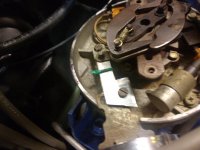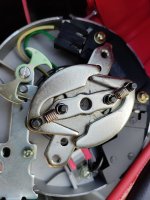johng
CCCUK Member
Trevor, I think you are reading Lars papers correctly and you should limit the amount of vacuum advance (although Oneball doesn't seem to think that this is particularly important).
As you say to reduce the amount of vacuum advance you need to limit the movement of the pin. Here is how I've done this with an aluminium plate on top of the attachment bar. In this photo I've put a vacuum on the can and it is fully retracted.

As you say to reduce the amount of vacuum advance you need to limit the movement of the pin. Here is how I've done this with an aluminium plate on top of the attachment bar. In this photo I've put a vacuum on the can and it is fully retracted.


